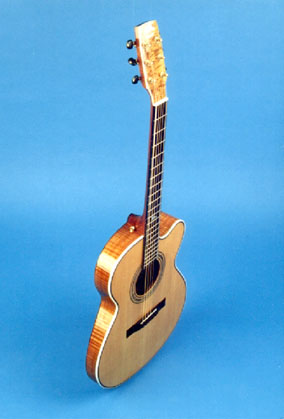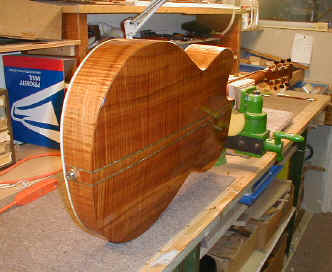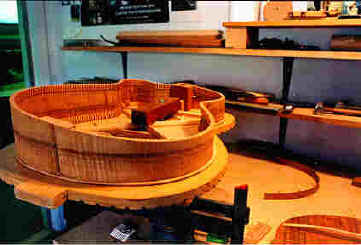Acoustic Guitar Magazine, May/June 1995 issue
by Tricia Harvey:
New England singer-songwriter Joel Zoss loves his new guitar--not because of its unusual appearance, or even for its pleasing acoustics. For Zoss, this wedge-shaped wonder signals an end to pain and injury which had threatened to cut short his musical career.
After decades of crooking his right arm over his deep-bodied "Dreadnaught" D-35, Zoss began to experience persistent bouts of shoulder pain. An orthopedic surgeon diagnosed calcific tendinitis (an injury in the shoulder joint) and told him he would have to keep his right arm close to his side when he played to avoid further injury. That left him with three choices: stop playing altogether, switch to lap steel or a Telecaster, or have surgery to shave bone from his shoulder socket. Zoss decided against all three and opted instead to have a full-size acoustic guitar designed that would allow his right arm to drop more naturally from his shoulder.
He commissioned luthier William Cumpiano to design and build the instrument, whose shape had to succeed ergonomically as well as acoustically. Cumpiano began by creating a Styrofoam mock-up, which Zoss would take home and tuck under his arm for several hours. After each session he reported back on how the shape felt, and they trimmed and pasted the mock-up until they arrived at an optimum shape that produced no pain: one that conforms to the natural wedge-shaped void formed between the arm and body when the arm is held out at a small angle. Cumpiano was not concerned about the guitar's radical asymmetry. "I'm convinced that in acoustic soundboxes, asymmetry is a benign thing," he says.
Because the new shape would dramatically reduce the air volume within the soundbox, however, the guitar was in danger of producing a tinkly, music-box sound. And Zoss wanted his guitar to have a cutaway, a short scale, and light-gauge strings--all of which would further contribute to a small sound.
Cumpiano's solution was to maximize the volume of the soundbox by designing a body with a very wide soundboard and a full-depth bottom side. He believed tha "flexible, compliant soundbox walls would avoid the glassy brilliance associated with stiffer, harder plates and lead to a deeper-resonating soundbox cavity." He therefore opted for very light plate thicknesses and moderately soft tonewoods: figured Hawaiian koa for the back, sides and neck, and a not-too-stiff Sitka spruce top. He pared down all the braces and then contoured the sides and headblock to accomodate the radically sloped, domed back.
Zoss' shoulder pain is a thing of the past, and he says the guitar "sounds and plays as good or better than any guitar I've ever owned," According to Cumpiano, non-ailing guitarists find the wedge shape refreshingly comfortable, too. "Now I'm trying to find a good reason why they shouldn't ALL be shaped this way," he says.
[ADDENDUM BY WRC] Since this article I've gotten a spate of calls from orthopedists who want to refer me to other players with "dreadnaught shoulder." One guitar playing orthopedist actually is recommending the shape to his guitar-playing clients at early stages of the injury "for prophylactic reasons."
A testimonial from yet another guitarist who's shoulder pain was relieved by the wedge
A musician's injury web page
Return
to William's Special Projects
More wedge guitars

Joel Zoss plays his new "wedge" for the first time.



